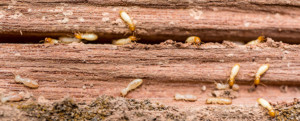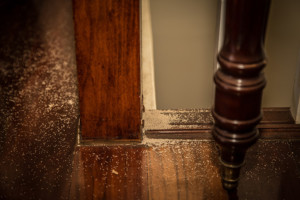When it comes to terrifying insects, homeowners generally agree that termites rank near the top of the list. They may not have the irritating sting of mosquitoes, the painful bite of ants, or the ick factor of cockroaches, but termites do something that’s even more troubling: Termites can wreck untold damage on structures — structures that cost a pretty penny and are typically difficult to repair. According to the USDA, the desert subterranean termite “causes an estimated $1.5 billion in losses each year.” And that’s just one subspecies!
In truth, though, estimating the total damage done by termites is essentially impossible. However, stopping these wood-devouring insects before they irreparably damage your home or commercial structure isn’t quite so impossible. This post will explain how to determine whether or not you have termites using just your naked eye, common termite signs, why termites so often go unnoticed, and related bugs that look an awful lot like termites.
- How do you identify termites?
- What do termite bites look like?
- Common signs of termites in your home
- Where termites are usually found?
- Why termite activity can go unnoticed?
- What bugs can be mistaken for termites?
- What times of the day termites are most active?
- Frequently Asked Questions (FAQ) about Termites for Smithereen Pest Control
How do you identify termites?
Termites can lay upwards of 25 eggs per minute, which makes correctly identifying them as soon as possible a property owner’s top priority. Unfortunately, termites are often easily confused with other species of insect. (See the “What bugs can be mistaken for termites?” down below.) But worry not! If you’re armed with the right information, you can determine if that creepy crawly you just spotted really is a termite.
can lay upwards of 25 eggs per minute, which makes correctly identifying them as soon as possible a property owner’s top priority. Unfortunately, termites are often easily confused with other species of insect. (See the “What bugs can be mistaken for termites?” down below.) But worry not! If you’re armed with the right information, you can determine if that creepy crawly you just spotted really is a termite.
When people initially spot termites, they typically see the swarmer-type termite. This bug looks a lot like a winged ant, but it has several noteworthy differences, such as:
- White, transparent wings with rounded tips that are the same length
- A tiny body no longer than a quarter of an inch
- A thorax and abdomen that don’t possess an easily identifiable demarcation (i.e., termites lack the “wasp waist” present in many similar insects)
- Short, straight antennae with no segmentation
Swarmers aren’t the only kinds of termites. You may also encounter soldier termites, which have darker heads, lighter-colored bodies, and black pincer-like mouths. Pale and soft, worker termites look remarkably like maggots — at least until you see them move. If you happen upon a group of worker termites, you’ll know it because they look like nothing more than a line of ambulatory rice grains.
What do termite bites look like?
 Termite bites aren’t readily distinguishable from other insect bites for one good reason: They very rarely bite people or animals. In fact, some experts maintain that they can’t sink their pincers into you. There’s some truth to that since only soldier termites have mandibles and they comprise less than 10 percent of a hive. But whether or not they bite, know that it’s an extremely unlikely occurrence. When termites bite, it’s almost always your structure that solely suffers.
Termite bites aren’t readily distinguishable from other insect bites for one good reason: They very rarely bite people or animals. In fact, some experts maintain that they can’t sink their pincers into you. There’s some truth to that since only soldier termites have mandibles and they comprise less than 10 percent of a hive. But whether or not they bite, know that it’s an extremely unlikely occurrence. When termites bite, it’s almost always your structure that solely suffers.
Common signs of termites in your home
Even though termites have a (somewhat) distinctive look, it’s not uncommon for homeowners to struggle with identifying an infestation. But because termites act in predictable ways, there are a number of distinctive signs you can look for. These include:
- Active infestations of wood piles or dead stumps located 25-feet or more from your structure’s foundation. While it’s natural to see termites disposing of dead wood, consider this an early warning sign and investigate further to make sure that they aren’t migrating to your property.
- Look for mud tubes outside your property, around the foundation, near plumbing, underneath wallpaper or paint, and/or on exterior walls or ceilings. Termites build mud tubes to and from their nests, and their presence is usually a dead giveaway that you have a problem. However, you may still find abandoned tubes if a pest-control service dealt with the problem in the past. There’s a foolproof way to see if it’s still active, though: Break open a small section of the tube. If you see termites or if the tube is miraculously repaired several days later, you have an active infestation. Also, consider getting a professional inspection even if the tubes seem dead. Incorrect assumptions about the state of a termite nest can lead to serious problems.
- Mud splatters inside or on the structure’s exterior. Termites may try to patch holes in sheetrock in order to seal off their hive from airflow.
- The discovery of termite damage while renovating. If you find mud tubes, damaged wood, and/or live termites while conducting common home repairs, then you likely have a termite problem and your property will need professional treatment.
- Strange structural problems suddenly cropping up. A sagging ceiling. A broken door jamb. A buckling wooden floor. Such issues may arise from problems such as rot — or they may indicate that you have termites.
- Discovering piles of small, dry, six-sided, tan-colored pellets. Known as “frass,” these pellets are termite excrement, and the bugs regularly eject it from their habitat. The bigger the pile, the larger the termite problem that you have.
- Finding dead swarmer termites around windowsills. Swarmers aren’t the first kinds of termite that a nest will produce. Indeed, it takes a significant amount of time for a nest to produce them, and their appearance heralds the existence of a very large bug population.
Where termites are usually found?

There are three main types of termites, namely the:
- Subterranean termite: Living below ground, these termites can stay undetected for years.
- Formosan termites: While there are thousands of termite species, these termites are considered the world’s most aggressive and destructive termite species.
- Drywood termites: Instead of making their home in soil or clay, drywood termites dwell directly in the very wood they eat.
Most of the states in the U.S. have to deal with subterranean termites, but only the American south, Texas, New Mexico, and California must manage Formosan termites. Drywood termites typically only appear in Florida and along the periphery of the United States’ southernmost border.
Why termite activity can go unnoticed?
Part of the reason why property owners fail to notice termites is that these canny insects tend to hide themselves either underground or directly in wood. However, that’s not the only reason. Consider how much of the space in your particular home or commercial structure lies outside of your field of view. Attics, crawl spaces, basements, wall cavities — all of them serve as ideal hiding places for termites to make their homes and find their meals.
What bugs can be mistaken for termites?
A number of insects look somewhat similar to termites or can damage your property in similar ways. Here’s a list of these bugs and ways in which you can differentiate them from termites:
- Powderpost Beetles (while these beetles will chew up wood and eject it in a powdery stream, it looks more like flour than the distinctively shaped termite frass)
- Carpenter Bees (similarly, these black-and-yellow bugs will bore into your property, but their holes are much larger than those of termites, and they leave dark-yellow stains on its exterior.
- Carpenter Ants (these look the most like termites, but unlike termites, they have bodies with three distinct segments, elbow-shaped antennae, and shorter wings of different lengths)
- Acrobat Ants (unlike termites, these insects will actively seek to bite you and release a terrible smell when disturbed)
What times of the day termites are most active?
Termites aren’t exactly diurnal or nocturnal. Rather, temperature does more to regulate their behavior. Termites typically remain most active when temperatures stay above 70 degrees Fahrenheit and rarely dip below 60 degrees Fahrenheit. This means that termites tend to cause problems during spring and summer, although they can technically remain active during any time of the year.
If you’re concerned about the possibility of having termites, contact us. Smithereen Pest Management Services has more than a century of experience in eliminating pests — and your good is our goal.
Frequently Asked Questions (FAQ) about Termites for Smithereen Pest Control
1. Can You See Termites in Wood?
Termites are often hidden within the structure of wood, making them difficult to spot with the naked eye. However, signs of termite activity such as mud tubes or damaged wood can indicate their presence.
2. Are Termites Visible to the Naked Eye?
While individual termites are small and may not be easily seen, termite swarms or signs of infestation can be visible with proper inspection.
3. Do Termites Have Visible Eyes?
Termites have compound eyes, but they are often not easily visible due to their small size and light sensitivity. These eyes help termites navigate and communicate within their colonies.
4. What Do Termites Look Like?
Termites are small insects with soft bodies, typically creamy white or pale brown in color. They have straight antennae, a thick waist, and a broad, oval-shaped body.
5. Are Termites Nocturnal Insects?
Termites are known to be primarily active at night, making them nocturnal insects. They prefer darkness and moisture, which influences their activity patterns.
6. How Can You Identify Termite Activity?
Termite activity can be identified by mud tubes on walls or foundation, damaged wood with a hollow sound when tapped, discarded wings near windows, or small piles of feces resembling sawdust.
7. What is the Appearance of a Termite Colony?
Termite colonies consist of different castes, including workers, soldiers, and alates (winged reproductives). Workers are pale and soft-bodied, soldiers have enlarged mandibles, and alates have wings for swarming.
8. How Do Termites Behave in Groups?
Termites exhibit social behavior within their colonies, with distinct roles assigned to different castes. They work together to forage for food, build tunnels, and maintain their nest.
9. What Do Termites Look Like Compared to Ants?
Termites can be distinguished from ants by their straight antennae, uniform waist, and equal-sized wings. Ants have elbowed antennae, constricted waists, and wings of different sizes.
10. Can I Detect Termites Before Seeing Them?
Early signs of termite infestations include mud tubes, swarmers (winged termites), wood damage, or hollow-sounding timber. Regular inspections by pest control professionals can help detect termites before they become a widespread issue.
If you suspect termite activity in your property or have further questions about termites and pest control measures, contact Smithereen Pest Control for expert advice and comprehensive solutions tailored to your specific needs. Our team is ready to assist you in safeguarding your home or business from the destructive effects of termite infestations.